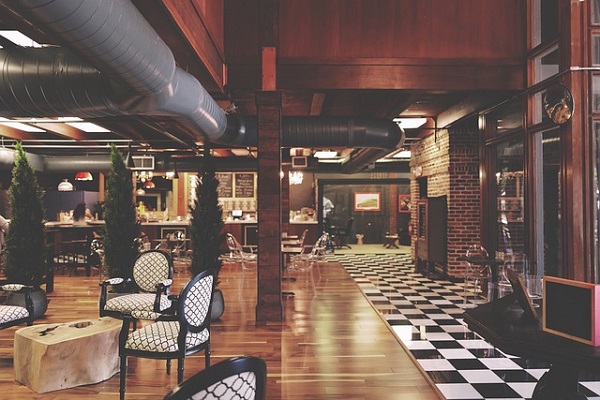
**This is a sponsored post**
Whether it’s a brand new premises or a refurb of an existing site, you’ll want to get the aesthetic of your restaurant just right. There are many elements that go into this: the type of furniture you go for, the lighting options you choose, how you paint or paper and decorate the walls.
For many restaurateurs, these decisions aren’t just about aesthetics, though, they’re about functionality too. And as far as functionality is concerned, there’s one other area where this is a key consideration: your choice of flooring.
Both the dining areas and kitchens of restaurants are high-traffic places, meaning that both durability and safety should be taken into account. With both this and appearance in mind, here are five great restaurant flooring options you may want to consider.
1. Concrete
By its nature, concrete is durable – and it can be one of the more cost-effective flooring choices for a restaurant, too. Polished concrete has grown in popularity in recent years as it can last for decades, it’s resistant to chips and scratches and can be waterproof.
Many businesses opt for polished concrete, which is available in a wide variety of different textures, colours and patterns – meaning you can make it look like a more expensive material.
On the downside, polished concrete can be slippery, which may not make it ideal for areas like kitchens, or areas near front doors which may get slippery during wet weather. You’ll also want to think about whether your restaurant is adequately heated in winter months to compensate for the coldness of a concrete floor – and remember, as a hard surface, it has the potential to be tough on the feet of kitchen and waiting staff if standing for long periods.
2. Resin
Resin floors are used widely in the hospitality industry – and with good reason. They can be applied to existing floor coverings without needing to remove the subfloor, and they’re a pretty cost-effective solution, too. If your existing floor is uneven, a resin coating can sort this out.
Choose the right resin flooring specialists and you could find that your resin floor will last for 20 years or more. It’s a durable, easy-to-clean solution that’s also water-resistant, and can be customised to suit your restaurant’s style. Similarly to polished concrete, though, resin floors can be slippery when wet (although an additional skid-resistant layer can be added), and can also feel cold. They also may not be a great choice in premises that suffer from damp issues, as excess moisture can damage resin flooring.
3. Cork
Own a wine bar? Cork’s a great option! It’s become popular thanks to its sustainable credentials – and it looks fantastic too.
While cork flooring can be susceptible to water damage – and while its soft nature can mean that heavy furniture and sharp objects can also cause damage – there are several benefits to using it in a restaurant setting. It’s an incredible comfortable material to stand and walk on (which your staff will appreciate!) and it’s relatively affordable and easy to maintain and clean. If you’re looking to resolve acoustic issues in your restaurant then this is another reason why cork is a good choice: it helps to absorb sound rather than helping it to reverberate around the space.
4. Stone
There’s no denying that natural stone is at the pricier end of the range when it comes to restaurant flooring materials, but it’s an investment that’s sure to last. It’s unlikely that you’ll ever need to replace your stone flooring, even with the huge amount of wear and tear that comes with a restaurant setting. If you have a restaurant with both indoor and outdoor space, stone flooring throughout can help to create a seamless look between the two areas.
There are certain things you’ll have to take into consideration, though. You may want to add an anti-slip coating to a stone flooring to avoid it becoming slippery when wet. Like polished concrete, it’s also a cold, hard choice, and it’s heavy too: you’ll want to ensure that whatever sits below the stone floor is strong enough to support it.
5. Laminate
While laminate is often designed to resemble hardwood at a fraction of the price, it can also be manufactured to look like natural stone or tile. It’s a flooring choice that’s low in cost, flexible and easy to maintain and clean, and it’s generally scratch-proof, too.
However, laminate can be badly damaged by moisture, which is more likely to happen if it hasn’t been installed correctly. Furthermore, any damage to laminate flooring will mean that the whole floor needs to be replaced, as it can’t simply be refinished.
There’s a huge variety of choices available for restaurant flooring, each suitable for different types of space and each with its own pros and cons. While the rest of your restaurant decor may seem more important, remember that the amount of traffic passing through your restaurant means that you need to choose your floor with functionality, not just its looks, in mind.
